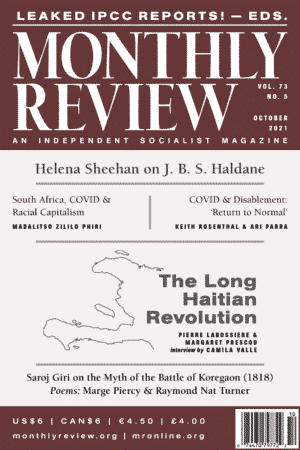Originally published at Monthly Review (October 2021, vol. 73, no. 5)
Suddenly, the nation and the world seemed to find itself
living in a protracted emergency variant of reality. From “normal” existence,
society metamorphosed into a prolonged state of “abnormality.” Virtually all
aspects of social and economic life, previously taken for granted, became
inaccessible by degrees to vast numbers of the populace. Physical movement,
gathering with friends and family, the desire to meet new people and possible
intimates, travel, shopping, even going to a bar or restaurant, all became
eminently restricted tasks. Daily activities of personal care and hygiene
occupied more and more of people’s functional time and mental concern. The
basic process of leaving the house required a great deal of pre-planning and
preparation. Anxieties escalated around people’s ability to continue engaging
in, or go about finding, paid work that would accommodate their restrictions
and needs, and whether their employer would offer paid sick leave if they or a
dependent became infected. Access to adequate, affordable, and safe health care
likewise became a more generalized and potentially fatal concern. In a word,
society itself had become disabled—disabled by the coronavirus; disabled by the
actions or inactions of various ruling and hegemonic institutions; disabled by
the preexisting social, political, and economic conditions of an unequal and
individualistic capitalist society.
Through it all, the watchword of virtually all politicians
occupying positions of power within the ruling circles of government—regardless
of party affiliation or political persuasion—has been the aim of a “return to
normal.” This sentiment resonated broadly across a public chafing under the
disabling conditions of pandemic existence. The development and widespread
distribution of a vaccine seemed to be the single beacon of hope—even as the
novel strain of the coronavirus mutated into more robust and resilient
variants, potentially requiring booster shots and additional vaccinations.2 It
is as if the pandemic purgatory we have been stuck in was a detour off the main
road, one wending laterally from the “normal,” desired route. Generalized
immunity, then, stands in prospect as an on-ramp back to society’s proper
timeline, back to the pre-pandemic vector, back to a “normal” future.
Abnormality Is a Preexisting Condition
For many disabled people in the United States and around the
world, however, the abnormal state of things over the last year and a half is
not such an estranged discontinuity from the previous state of things.
Certainly, just like everyone, pandemic life for disabled people has been
exceedingly difficult, painful, oppressive, and deadly. But the “normal” of
pre-pandemic life was also exceedingly difficult, painful, oppressive, and
deadly. To be disabled in contemporary capitalist society is to live in a
permanent state of socially constructed “abnormality.” Illustrator Sam Schäfer,
for example, has aptly depicted this phenomenon in a series of graphics on
disabled people and the pandemic, published online in early 2021.3
In one of the panels in the comic titled “And Now Here We
Are,” Schäfer writes: “We died the same way many of us lived: in hospital,
isolated, stuck indoors, financially struggling, isolated.” As the caption
explains: “Each point is illustrated with an empty hospital bed, a silhouette
sat in a jar, a closed door, a broken sad and very adorable piggy bank with
little coins in it, and nothing.” A subsequent panel features the words: “Every
day I see people wishing for things to go back to normal. Back to the way
things were. Where we were still suffering and dying.” The inscription
accompanies a drawing of crutches lying abandoned on a patch of grass beneath a
rainbow and sunshine.4
